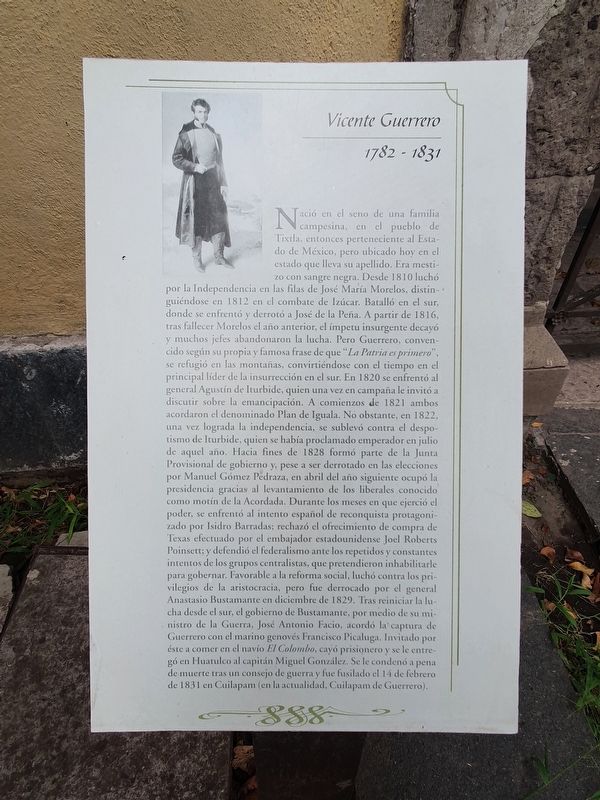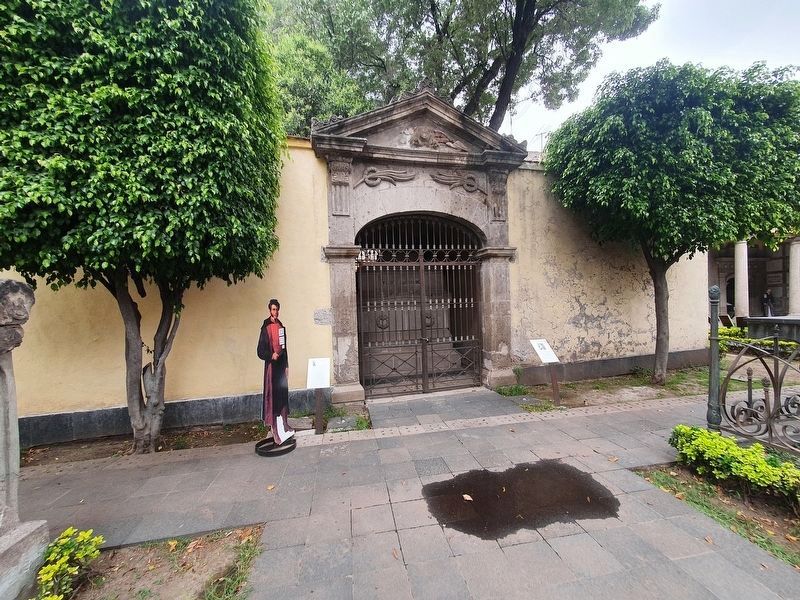Centro Histórico in Ciudad de México, Mexico — The Valley of Mexico (The Central Highlands)
Vicente Guerrero
1782-1831
Nació en el seno de una familia campesina, en el pueblo de Tixtla, entonces perteneciente al Estado de México, pero ubicado hoy en el estado que lleva su apellido. Era mestizo con sangre negra. Desde 1810 luchó por la Independencia en las filas de José María Morelos, distinguiéndose en 1812 en el combate de Izúcar. Batalló en el sur, donde se enfrentó y derrotó a José de la Peña. A partir de 1816, tras fallecer Morelos el año anterior, el ímpetu insurgente decayó y muchos jefes abandonaron la lucha. Pero Guerrero, convencido según su propia y famosa frase de que "La Patria es primero", se refugió en las montañas, convirtiéndose con el tiempo en el principal líder de la insurrección en el sur. En 1820 se enfrentó al general Agustín de Iturbide, quien una vez en campaña le invitó a discutir sobre la emancipación. A comienzos de 1821 ambos acordaron el denominado Plan de Iguala. No obstante, en 1822, una vez lograda la independencia, se sublevó contra el despotismo de Iturbide, quien se había proclamado emperador en julio de aquel año. Hacia fines de 1828 formó parte de la Junta Provisional de gobierno y, pese a ser derrotado en las elecciones por Manuel Gómez Pedraza, en abril del año siguiente ocupó la presidencia gracias al levantamiento de los liberales conocido como motín de la Acordada. Durante los meses en que ejerció el poder, se enfrentó al intento español de reconquista protagonizado por Isidro Barradas; rechazó el ofrecimiento de compra de Texas efectuado por el embajador estadounidense Joel Roberts Poinsett; y defendió el federalismo ante los repetidos y constantes intentos de los grupos centralistas, que pretendieron inhabilitarle para gobernar. Favorable a la reforma social, luchó contra los privilegios de la aristocracia, pero fue derrocado por el general Anastasio Bustamante en diciembre de 1829. Tras reiniciar la lucha desde el sur, el gobierno de Bustamante, por medio de su ministro de la Guerra, José Antonio Facio, acordó la captura de Guerrero con el marino genovés Francisco Picaluga. Invitado por éste a comer en el navío El Colombo, cayó prisionero y se le entregó en Huatulco al capitán Miguel González. Se le condenó a pena de muerte tras un consejo de guerra y fue fusilado el 14 de febrero de 1831 en Cuilapam (en la actualidad, Cuilapam de Guerrero).
Vicente Guerrero
1782-1831
He was born into a peasant family, in the town of Tixtla, then belonging to the State of Mexico,
but located today in the state that bears his surname. His family heritage was Black and a mix of other races. From 1810 he fought
for Independence in the ranks of José María Morelos, distinguishing himself in 1812 in the battle of Izúcar. He fought in the south, where he faced and defeated José de la Peña. From 1816,
after Morelos died the previous year, the insurgent momentum waned and many leaders abandoned the fight. But Guerrero, convinced according to his own famous phrase that "The Homeland comes first," took refuge in the mountains, eventually becoming the main leader of the insurrection in the south. In 1820 he confronted General Agustín de Iturbide, who once in the campaign invited him to
discuss emancipation. At the beginning of 1821 both agreed on the so-called Plan of Iguala. However, in 1822, once independence was achieved, he revolted against the despotism of Iturbide, who had proclaimed himself emperor in July of that year. Towards the end of 1828 he was part of the Provisional Governmental Board and, despite being defeated in the elections
by Manuel Gómez Pedraza, in April of the following year he occupied the
presidency thanks to the uprising of the Liberals known as the Mutiny of the Agreed. During the months in which he exercised power, he faced the Spanish attempt at reconquest led by Isidro Barradas; he rejected the offer of the purchase of Texas made
by the US ambassador Joel Roberts Poinsett; and he defended federalism in the face of repeated and constant attempts by centralist groups, which sought to disqualify him from governing. Favorable to social reform, he fought against the privileges of the aristocracy, but was overthrown by General Anastasio Bustamante in December 1829. After restarting the fighting from the south, the Bustamante government, through its Minister of War, José Antonio Facio, agreed to capture Guerrero with the Genoan sailor Francisco Picaluga. Invited by him to eat on board the ship El Colombo, he fell prisoner and was delivered in Huatulco to Captain Miguel González. He was sentenced to death after a court martial and was shot on February 14, 1831 in Cuilapam (now Cuilapam de Guerrero).
Topics. This historical marker is listed in these topic lists: African Americans • Patriots & Patriotism • Wars, Non-US. A significant historical date for this entry is February 14, 1831.
Location. 19° 26.349′ N, 99° 8.887′ W. Marker is in Ciudad de México. It is in Centro Histórico. Marker can be reached from Calle San Fernando, on the right when traveling west. The marker is on the grounds of the Panteón San Fernando. Touch for map. Marker is at or near this postal address: C San Fernando 17, Ciudad de México 06300, Mexico. Touch for directions.
Other nearby markers. At least 8 other markers are within walking distance of this marker. Mariano Riva Palacio (here, next to this marker); Benito Juárez (here, next to this marker); Juan de la Granja (a few steps from this marker); Isadora Duncan (a few steps from this marker); Ignacio Comonfort (a few steps from this marker); Tomás Mejía (a few steps from this marker); Miguel Miramón (a few steps from this marker); Ignacio Zaragoza (a few steps from this marker). Touch for a list and map of all markers in Ciudad de México.
Credits. This page was last revised on March 1, 2023. It was originally submitted on March 1, 2023, by J. Makali Bruton of Accra, Ghana. This page has been viewed 51 times since then and 13 times this year. Photos: 1, 2. submitted on March 1, 2023, by J. Makali Bruton of Accra, Ghana.

